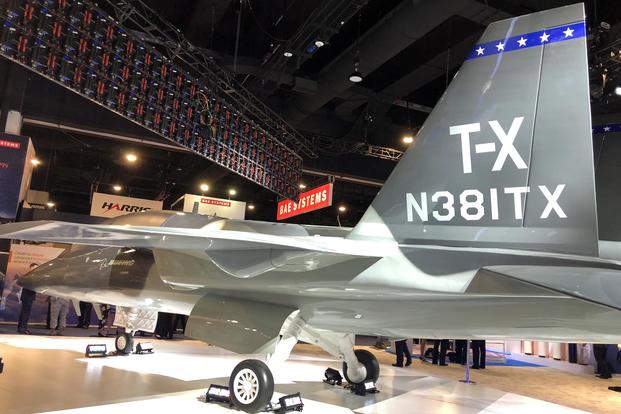The U.S. Air Force is hoping to grow its total force by 4,400 airmen, add a new fighter to its inventory, and pump more money into weapon sustainment and ongoing research programs, such as the B-21 Long Range Strike Bomber project, according to the service's fiscal 2020 budget request.
As anticipated, the Air Force will officially ask to fund eight brand-new F-15EX fourth-plus generation fighters at a cost of $1.05 billion to gradually begin replacing its older F-15C/D Eagle fleet, the budget documents reveal. Service officials recently disclosed the Air Force needs to boost its fighter inventory, but it had not expected to do so with an F-15X variant.
"We remain committed to the F-35 and its game-changing capabilities … [but the budget] balances readiness and modernization in the near-term by procuring eight F-15EX aircraft to refresh our [current] F-15 fleet, allowing us to benefit from foreign partner investments in the F-15 line," said Air Force Maj. Gen. John Pletcher. Pletcher, the deputy assistant secretary for budget at the Air Force's Office of the Assistant Secretary for Financial Management and the Comptroller at the Pentagon, briefed reporters Tuesday.
The Air Force estimates it will cost $80 million per aircraft, but that cost could rise to roughly $125 million for each of the eight jets "to set up the line" and account for non-recurring engineering costs in the first year of procurement, he said. "And, of course, you have the spares and everything else as well."
By comparison, the cost of the Air Force’s F-35A has dropped to $89 million per aircraft.
The service is requesting $204.8 billion, including "non-blue" dollars, which fall under the Air Force but are not managed by the service. Of that, the service would oversee $165.6 billion, a six percent increase from its fiscal 2019 request.
The Air Force would plus-up its active-duty end strength to 332,800 airmen, an increase of 3,700 airmen from last year's request, the documents show. Additionally, the service wants 700 airmen across its reserve force (600 in the Guard, 100 in the reserve).
Related links:
- New or Used: The Air Force's Two Tricky Paths to 386 Operational Squadrons
- Lawmakers Concerned Push for F-15X Is Reducing F-35 Procurement
- Air Force Wants to Add 4,700 Airmen; Buy More F-35s, Drones
The budget request will maintain the service's current 312 squadrons, instead of adding units to meet the Air Force's overall goal of 386 operational squadrons over the next decade. Pletcher said the 386-squadron study was conducted at the same time officials began crafting the latest budget request, so movement regarding the proposed 74 additional squadrons "will happen in subsequent years."
"We must increase our capacity to evolve," he said. He added that the budget "does set the conditions for success" to field resources "faster and smarter," which will pave the way to 386 squadrons.
To sustain readiness levels, the service wants to invest more than $33 billion across maintenance, infrastructure and max executable flight hours, according to the Defense Department overview budget request. While the service aims to increase mission capability, total flight hours, including those supporting warfighting overseas, will decrease, from 1.46 million in 2019 to 1.33 million in 2020.
"This year's request was based on the flying hours we believe we will be able to execute based on historical usage," said service spokeswoman Ann Stefanek.
The most striking change comes to the service's Overseas Contingency Operations (OCO) budget. The Air Force is asking for $42.3 billion, as opposed to the $12.8 billion it originally intended to seek, the budget says. The increase, which is not subject to spending caps, is based on President Donald Trump's request to ask for more money in the warfighting account to bypass congressional spending limits.
The OCO hike does not change the Air Force's overall request. Instead, it shifts programs that would normally fall under procurement -- including new MQ-9 Reaper drones and weapons such as the precision-guided Joint Direct Attack Munitions -- under OCO, per the budget documents.
The service hopes to make heavy gains in research, development, test and evaluation programs such as the B-21 Raider; its new T-X trainer to replace its T-38 Talon fleet; next-gen overhead persistent infrared (OPIR) satellites for missile detection; and especially its next-generation air dominance -- a potential sixth-gen fighter or "family of systems" -- programs. The service is seeking $35.4 billion for the efforts, a nearly 15 percent increase from last year's allocated funding.
Next-Generation Air Dominance could receive $1 billion in new funding, as opposed to the $430 enacted in the fiscal 2019 budget.
Additional highlights:
- More pilots. The Air Force wants to produce 1,480 pilots in 2020, the documents show. Last year, the service said it will steadily ramp up its pilot training to produce 1,500 pilots a year by fiscal 2022.
- More F-35As. The service wants 48 F-35A Joint Strike Fighters, down eight from the 56 it received last year at a cost of $4.9 billion. The service requested 48 in fiscal 2019, but got additional funding from lawmakers. The Air Force is supposed to plus-up its fifth-generation inventory to 54 aircraft per year beginning in fiscal 2021.
- More aircraft overall. The budget adds a total of 74 new aircraft across the service's total aircraft inventory to reach 5,500 planes.
- Another T-X. The service hopes to buy one new T-X trainer from Boeing Co. to have a total of three aircraft by the end of 2020.
- Fewer KC-46s. The service will request three fewer KC-46 Pegasus aircraft -- 12 total -- as opposed to the 15 in last year's request. Pletcher said Congress added three additional aircraft in the fiscal 2019 request, so the Air Force is on track to have 15 by 2020.
- More bombs. The budget has funding for nearly 3,300 new bombs, including Small Diameter Bomb I and II variants, the AGM-158 Joint Air-to-Surface Standoff Missile-Extended Range (JASSM-ER), and AIM 120-D Advanced Medium-Range Air-to-Air Missiles (AMRAAMs), among others.
-- Oriana Pawlyk can be reached at oriana.pawlyk@military.com. Follow her on Twitter at @Oriana0214.










